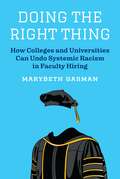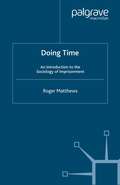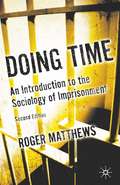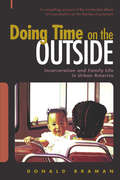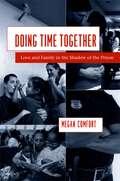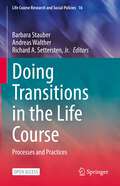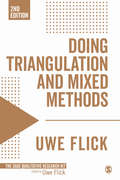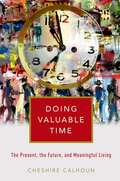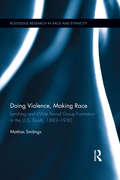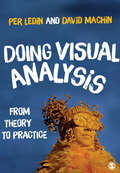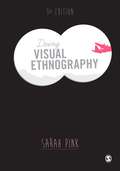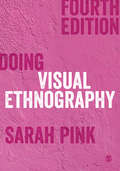- Table View
- List View
Doing Style: Youth and Mass Mediation in South India
by Constantine V. NakassisIn Doing Style, Constantine V. Nakassis explores the world of youth and mass media in South India, where what Tamil youth call “style” anchors their day-to-day lives and media worlds. Through intimate ethnographic descriptions of college life in Tamil Nadu, Nakassis explores the complex ways that acts and objects of style such as brand fashion, English slang, and film representations express the multiple desires and anxieties of this generation, who live in the shadow of the promise of global modernity. As Nakassis shows, while signs of the global, modern world are everywhere in post-liberalization India, for most of these young people this world is still very distant—a paradox that results in youth’s profound sense of being in between. This in-betweenness manifests itself in the ambivalent quality of style, the ways in which stylish objects are necessarily marked as counterfeit, mixed, or ironical. In order to show how this in-betweenness materializes in particular media, Nakassis explores the entanglements between youth peer groups and the sites where such stylish media objects are produced, arguing that these entanglements deeply condition the production and circulation of the media objects themselves. The result is an important and timely look at the tremendous forces of youth culture, globalization, and mass media as they interact in the vibrancy of a rapidly changing India.
Doing Style: Youth and Mass Mediation in South India
by Constantine V. NakassisIn Doing Style, Constantine V. Nakassis explores the world of youth and mass media in South India, where what Tamil youth call “style” anchors their day-to-day lives and media worlds. Through intimate ethnographic descriptions of college life in Tamil Nadu, Nakassis explores the complex ways that acts and objects of style such as brand fashion, English slang, and film representations express the multiple desires and anxieties of this generation, who live in the shadow of the promise of global modernity. As Nakassis shows, while signs of the global, modern world are everywhere in post-liberalization India, for most of these young people this world is still very distant—a paradox that results in youth’s profound sense of being in between. This in-betweenness manifests itself in the ambivalent quality of style, the ways in which stylish objects are necessarily marked as counterfeit, mixed, or ironical. In order to show how this in-betweenness materializes in particular media, Nakassis explores the entanglements between youth peer groups and the sites where such stylish media objects are produced, arguing that these entanglements deeply condition the production and circulation of the media objects themselves. The result is an important and timely look at the tremendous forces of youth culture, globalization, and mass media as they interact in the vibrancy of a rapidly changing India.
Doing Style: Youth and Mass Mediation in South India
by Constantine V. NakassisIn Doing Style, Constantine V. Nakassis explores the world of youth and mass media in South India, where what Tamil youth call “style” anchors their day-to-day lives and media worlds. Through intimate ethnographic descriptions of college life in Tamil Nadu, Nakassis explores the complex ways that acts and objects of style such as brand fashion, English slang, and film representations express the multiple desires and anxieties of this generation, who live in the shadow of the promise of global modernity. As Nakassis shows, while signs of the global, modern world are everywhere in post-liberalization India, for most of these young people this world is still very distant—a paradox that results in youth’s profound sense of being in between. This in-betweenness manifests itself in the ambivalent quality of style, the ways in which stylish objects are necessarily marked as counterfeit, mixed, or ironical. In order to show how this in-betweenness materializes in particular media, Nakassis explores the entanglements between youth peer groups and the sites where such stylish media objects are produced, arguing that these entanglements deeply condition the production and circulation of the media objects themselves. The result is an important and timely look at the tremendous forces of youth culture, globalization, and mass media as they interact in the vibrancy of a rapidly changing India.
Doing Surveys Online
by Dr Vera ToepoelLecturers, request your electronic inspection copy Vera Toepoel’s practical, how-to guide to doing surveys online takes you through the entire process of using surveys, from systematically recruiting respondents, to designing the internet survey, to processing the survey data and writing it up. This book helps students and researchers in identifying possible strategies to make the best use of online surveys, providing pro’s and con’s, and do’s and don’ts for each strategy. It also explores the latest opportunities and developments that have arisen in the field of online surveys, including using social networks, and provides expert guidance and examples of best practice throughout. Suitable for those starting a research project or conducting a survey in a professional capacity, this book is the ideal go-to reference for anyone using internet surveys, be it a beginner or a more experienced survey researcher.
Doing Surveys Online (PDF)
by Dr Vera ToepoelLecturers, request your electronic inspection copy Vera Toepoel’s practical, how-to guide to doing surveys online takes you through the entire process of using surveys, from systematically recruiting respondents, to designing the internet survey, to processing the survey data and writing it up. This book helps students and researchers in identifying possible strategies to make the best use of online surveys, providing pro’s and con’s, and do’s and don’ts for each strategy. It also explores the latest opportunities and developments that have arisen in the field of online surveys, including using social networks, and provides expert guidance and examples of best practice throughout. Suitable for those starting a research project or conducting a survey in a professional capacity, this book is the ideal go-to reference for anyone using internet surveys, be it a beginner or a more experienced survey researcher.
Doing the Right Thing: How Colleges and Universities Can Undo Systemic Racism in Faculty Hiring
by Marybeth GasmanAn honest confrontation of systemic racism in faculty hiring—and what to do about itWhile colleges and universities have been lauded for increasing student diversity, these same institutions have failed to achieve any comparable diversity among their faculty. In 2017, of the nation’s full-time, tenure-track and tenured faculty, only 3 percent each were Black men, Black women, Hispanic men, and Hispanic women. Only 6 percent were Asian/Pacific Islander men, 5 percent were Asian/Pacific Islander women, and 1 percent were American Indian/Alaska Native. Why are the numbers so abysmal? In Doing the Right Thing, Marybeth Gasman takes a hard, insightful look at the issues surrounding the recruitment and hiring of faculty of color. Relying on national data and interviews with provosts, deans, and department chairs from sixty major universities, Gasman documents the institutional forces stymieing faculty diversification, and she makes the case for how such deficiencies can and should be rectified.Even as institutions publicly champion inclusive excellence and the number of doctoral students of color increases, Gasman reveals the entrenched constraints contributing to the faculty status quo. Impediments to progress include the alleged trade-off between quality and diversity, the power of pedigree, the rigidity of academic pipelines, failures of administrative leadership, lack of accountability among administration and faculty, and the opacity and arbitrariness of the recruitment and hiring process. Gasman contends that leaders must acknowledge institutional failures of inclusion, pervasive systemic racism, and biases that restrict people of color from pursuing faculty careers.Recognizing that individuals from all backgrounds are essential to the creation and teaching of knowledge, Doing the Right Thing puts forth a concrete call for colleges and universities to take action and do better.
Doing Time: An Introduction to the Sociology of Imprisonment
by R. MatthewsThis book is designed to acquaint students with some of the main issues associated with the emergence and development of the modern prison. It draws on a range of sociological theorising in order to analyse the organisation and the functioning of the prison. It examines the conditions for the expansion of the prison and explores the possibilities for limiting prison use through the development of alternatives to custody. In particular, it looks in some detail at the relation between imprisonment and class, age, gender and race.
Doing Time: An Introduction to the Sociology of Imprisonment
by Roger MatthewsThe new edition of Doing Time brings this widely recognized book up-to-date and provides an accessible and informed discussion of current debates around prisons and penal policy. Drawing on a range of international material the book provides a critical sociological analysis of developments in imprisonment.
Doing Time on the Outside: Incarceration and Family Life in Urban America
by Donald Braman"Stigma, shame and hardship---this is the lot shared by families whose young men have been swept into prison. Braman reveals the devastating toll mass incarceration takes on the parents, partners, and children left behind." -Katherine S. Newman "Doing Time on the Outside brings to life in a compelling way the human drama, and tragedy, of our incarceration policies. Donald Braman documents the profound economic and social consequences of the American policy of massive imprisonment of young African American males. He shows us the link between the broad-scale policy changes of recent decades and the isolation and stigma that these bring to family members who have a loved one in prison. If we want to understand fully the impact of current criminal justice policies, this book should be required reading." -Mark Mauer, Assistant Director, The Sentencing Project "Through compelling stories and thoughtful analysis, this book describes how our nation's punishment policies have caused incalculable damage to the fabric of family and community life. Anyone concerned about the future of urban America should read this book." -Jeremy Travis, The Urban Institute In the tradition of Elijah Anderson's Code of the Street and Katherine Newman's No Shame in My Game, this startling new ethnography by Donald Braman uncovers the other side of the incarceration saga: the little-told story of the effects of imprisonment on the prisoners' families. Since 1970 the incarceration rate in the United States has more than tripled, and in many cities-urban centers such as Washington, D.C.-it has increased over five-fold. Today, one out of every ten adult black men in the District is in prison and three out of every four can expect to spend some time behind bars. But the numbers don't reveal what it's like for the children, wives, and parents of prisoners, or the subtle and not-so-subtle effects mass incarceration is having on life in the inner city. Author Donald Braman shows that those doing time on the inside are having a ripple effect on the outside-reaching deep into the family and community life of urban America. Braman gives us the personal stories of what happens to the families and communities that prisoners are taken from and return to. Carefully documenting the effects of incarceration on the material and emotional lives of families, this groundbreaking ethnography reveals how criminal justice policies are furthering rather than abating the problem of social disorder. Braman also delivers a number of genuinely new arguments. Among these is the compelling assertion that incarceration is holding offenders unaccountable to victims, communities, and families. The author gives the first detailed account of incarceration's corrosive effect on social capital in the inner city and describes in poignant detail how the stigma of prison pits family and community members against one another. Drawing on a series of powerful family portraits supported by extensive empirical data, Braman shines a light on the darker side of a system that is failing the very families and communities it seeks to protect.
Doing Time Together: Love and Family in the Shadow of the Prison
by Megan ComfortBy quadrupling the number of people behind bars in two decades, the United States has become the world leader in incarceration. Much has been written on the men who make up the vast majority of the nation’s two million inmates. But what of the women they leave behind? Doing Time Together vividly details the ways that prisons shape and infiltrate the lives of women with husbands, fiancés, and boyfriends on the inside. Megan Comfort spent years getting to know women visiting men at San Quentin State Prison, observing how their romantic relationships drew them into contact with the penitentiary. Tangling with the prison’s intrusive scrutiny and rigid rules turns these women into “quasi-inmates,” eroding the boundary between home and prison and altering their sense of intimacy, love, and justice. Yet Comfort also finds that with social welfare weakened, prisons are the most powerful public institutions available to women struggling to overcome untreated social ills and sustain relationships with marginalized men. As a result, they express great ambivalence about the prison and the control it exerts over their daily lives. An illuminating analysis of women caught in the shadow of America’s massive prison system, Comfort’s book will be essential for anyone concerned with the consequences of our punitive culture.
Doing Time Together: Love and Family in the Shadow of the Prison
by Megan ComfortBy quadrupling the number of people behind bars in two decades, the United States has become the world leader in incarceration. Much has been written on the men who make up the vast majority of the nation’s two million inmates. But what of the women they leave behind? Doing Time Together vividly details the ways that prisons shape and infiltrate the lives of women with husbands, fiancés, and boyfriends on the inside. Megan Comfort spent years getting to know women visiting men at San Quentin State Prison, observing how their romantic relationships drew them into contact with the penitentiary. Tangling with the prison’s intrusive scrutiny and rigid rules turns these women into “quasi-inmates,” eroding the boundary between home and prison and altering their sense of intimacy, love, and justice. Yet Comfort also finds that with social welfare weakened, prisons are the most powerful public institutions available to women struggling to overcome untreated social ills and sustain relationships with marginalized men. As a result, they express great ambivalence about the prison and the control it exerts over their daily lives. An illuminating analysis of women caught in the shadow of America’s massive prison system, Comfort’s book will be essential for anyone concerned with the consequences of our punitive culture.
Doing Time Together: Love and Family in the Shadow of the Prison
by Megan ComfortBy quadrupling the number of people behind bars in two decades, the United States has become the world leader in incarceration. Much has been written on the men who make up the vast majority of the nation’s two million inmates. But what of the women they leave behind? Doing Time Together vividly details the ways that prisons shape and infiltrate the lives of women with husbands, fiancés, and boyfriends on the inside. Megan Comfort spent years getting to know women visiting men at San Quentin State Prison, observing how their romantic relationships drew them into contact with the penitentiary. Tangling with the prison’s intrusive scrutiny and rigid rules turns these women into “quasi-inmates,” eroding the boundary between home and prison and altering their sense of intimacy, love, and justice. Yet Comfort also finds that with social welfare weakened, prisons are the most powerful public institutions available to women struggling to overcome untreated social ills and sustain relationships with marginalized men. As a result, they express great ambivalence about the prison and the control it exerts over their daily lives. An illuminating analysis of women caught in the shadow of America’s massive prison system, Comfort’s book will be essential for anyone concerned with the consequences of our punitive culture.
Doing Transitions in the Life Course: Processes and Practices (Life Course Research and Social Policies #16)
by Barbara Stauber Andreas Walther Richard A. SetterstenThis open access book provides a unique research perspective on life course transitions. Here, transitions are understood as social processes and practices. Leveraging the recent “practice turn” in the social sciences, the contributors analyze how life course transitions are “done.” This book introduces the concept of “doing transitions” and its implications for theories and methods. It presents fresh empirical research on “doing transitions” in different life phases (e.g., childhood, young adulthood, later life) and life domains (e.g., education, work, family, health, migration). It also emphasizes themes related to institutions and organizations, time and normativity, materialities (such as bodies, spaces, and artifacts), and the reproduction of social inequalities in education and welfare. In coupling this new perspective with empirical illustrations, this book is an indispensable resource for scholars from demography, sociology, psychology, social work and other scientific fields, as well as for students, counselors and practitioners, and policymakers.
Doing Triangulation and Mixed Methods (Qualitative Research Kit #8)
by Dr Uwe FlickThis book shows you not just how to use triangulation as a strategy of quality management, but also how to use it as an approach to designing and doing qualitative research in a more comprehensive way. Flick links triangulation with current debates about using mixed methods, and outlines their potential for extending qualitative research, addressing questions such as how such research can benefit from integrating quantitative (mixed methods), or from working more generally with more than one approach (triangulation).
Doing Triangulation and Mixed Methods (Qualitative Research Kit #8)
by Dr Uwe FlickThis book shows you not just how to use triangulation as a strategy of quality management, but also how to use it as an approach to designing and doing qualitative research in a more comprehensive way. Flick links triangulation with current debates about using mixed methods, and outlines their potential for extending qualitative research, addressing questions such as how such research can benefit from integrating quantitative (mixed methods), or from working more generally with more than one approach (triangulation).
Doing Valuable Time: The Present, the Future, and Meaningful Living
by Cheshire CalhounDoing Valuable Time explores the human concern with expending our life's time well. We pursue what we take to be valuable, strive to live meaningfully, judge whether our present circumstances are good enough, and have standards for what we are willing to take an interest in. Doing valuable time, however, is not an easy task. Expending time on big, important life-projects often entails lots of little time expenditures on the seemingly meaningless, and our ability to take an interest in our own futures is fragile. our present circumstances often leaves us with endless opportunities for discontent-too much spare time, too much of the same thing all of the time, or too much time stuck in stalled projects. Doing Valuable Time is a book about the difficulties we face in achieving valuable time and the interest--and disinterest--we take in our own present and future. Professor Cheshire Calhoun explores the implications of using time well in order to achieve the unachievable: living a meaningful life. Through seven chapters of rigorous philosophical inquiry and compelling practical insights, Calhoun explains the motivating interest we take in our future, and how hope sustains activities that are likely to fail. Doing Valuable Time shows the value of committing ourselves to having a particular future, and the possibilities for finding contentment with the imperfect present.
Doing Violence, Making Race (Routledge Research in Race and Ethnicity)
by Mattias SmångsThe subject of lynching has spawned a vast body of important research, but this research suffers from important blind spots and disjunctures. By broadening the scope of research problem formulation, staking out new theoretical-analytical tracks, and drawing upon recent innovations in statistical methodology to analzye newer and more detailed data, Doing Violence, Making Race offers an innovative contribution to our understanding of this grim subject matter and its place within the broader history and sociology of US race relations. Indeed, this volume demonstrates how different forms of lynching fed off and into the formation of the racial group boundaries and identities at the foundation of the Jim Crow system. The book also demonstrates that as dominant white racial ideologies and conceptions took an extremist turn, lethal mob violence against African Americans increasingly assumed the form of public lynchings, serving to transform symbolic representations of blacks into social stigma and exclusion. Finally, Smångs also explores how public lynchings were expressive as well as generative of the collective white racial identity mobilized through the southern branch of the Democratic Party, whilst private lynchings were related to whites’ interracial status and social identity concerns on the interpersonal level. The most complete and complex scholarly treatment of this grim subject to date, this enlightening volume will be of interest to undergraduate and graduate students interested in areas such as Sociology, Political Science, History, Criminology/Criminal Justice, Anthropology, American Studies, African-American and Whiteness Studies.
Doing Violence, Making Race (Routledge Research in Race and Ethnicity)
by Mattias SmångsThe subject of lynching has spawned a vast body of important research, but this research suffers from important blind spots and disjunctures. By broadening the scope of research problem formulation, staking out new theoretical-analytical tracks, and drawing upon recent innovations in statistical methodology to analzye newer and more detailed data, Doing Violence, Making Race offers an innovative contribution to our understanding of this grim subject matter and its place within the broader history and sociology of US race relations. Indeed, this volume demonstrates how different forms of lynching fed off and into the formation of the racial group boundaries and identities at the foundation of the Jim Crow system. The book also demonstrates that as dominant white racial ideologies and conceptions took an extremist turn, lethal mob violence against African Americans increasingly assumed the form of public lynchings, serving to transform symbolic representations of blacks into social stigma and exclusion. Finally, Smångs also explores how public lynchings were expressive as well as generative of the collective white racial identity mobilized through the southern branch of the Democratic Party, whilst private lynchings were related to whites’ interracial status and social identity concerns on the interpersonal level. The most complete and complex scholarly treatment of this grim subject to date, this enlightening volume will be of interest to undergraduate and graduate students interested in areas such as Sociology, Political Science, History, Criminology/Criminal Justice, Anthropology, American Studies, African-American and Whiteness Studies.
Doing Visual Analysis: From Theory to Practice
by David Machin Professor Per LedinVisual communication shapes our perceptions and experiences of the world. This is not only a question of photographs or video, but also the design of websites, the use of data visualization software, the branding of packaging, and even the design of buildings and furniture. Doing Visual Analysis: From Theory to Practices provides a concrete set of tools to research and analyse this wide range of visual data. Showing students how to apply the right mix of methods to their own research projects, it equips them with the skills to break down and analyse the range of contemporary visual communication. The book: Provides examples of how and where certain tools can be used in a project or dissertation Discusses the type of research questions best suited to different tools and methods Shows students how to mix approaches and use tools alongside other methods, such as content analysis or interviews Doing Visual Analysis is an essential companion for students and researchers of visual data across the social sciences.
Doing Visual Analysis: From Theory to Practice
by David Machin Professor Per LedinVisual communication shapes our perceptions and experiences of the world. This is not only a question of photographs or video, but also the design of websites, the use of data visualization software, the branding of packaging, and even the design of buildings and furniture. Doing Visual Analysis: From Theory to Practices provides a concrete set of tools to research and analyse this wide range of visual data. Showing students how to apply the right mix of methods to their own research projects, it equips them with the skills to break down and analyse the range of contemporary visual communication. The book: Provides examples of how and where certain tools can be used in a project or dissertation Discusses the type of research questions best suited to different tools and methods Shows students how to mix approaches and use tools alongside other methods, such as content analysis or interviews Doing Visual Analysis is an essential companion for students and researchers of visual data across the social sciences.
Doing Visual Ethnography
by Dr Sarah PinkEssential reading for anyone wishing to engage with images, technologies and society, Doing Visual Ethnography is a milestone in ethnographic and visual research. The third edition of this classic text includes new chapters on web-based practices for visual ethnography and the issues surrounding the representation, interpretation and authoring of knowledge with the rise of digital media. The book provides a foundation for thinking about visual ethnography and introduces the practical and theoretical issues relating to the visual and digital technologies used in the field. Drawing upon her original research and the experiences of other ethnographers, Sarah Pink once again challenges our understanding of the world and sets new agendas for visual ethnography by: Helpfully illustrating key concepts within real world contexts Introducing examples from both analogue and digital media Exploring material and electronic texts Setting out the shift towards applied, participatory and public visual scholarship. This book is a must-have for students and researchers across the social sciences who are interested in incorporating audiovisual media into their research practice. Available with Perusall—an eBook that makes it easier to prepare for class Perusall is an award-winning eBook platform featuring social annotation tools that allow students and instructors to collaboratively mark up and discuss their SAGE textbook. Backed by research and supported by technological innovations developed at Harvard University, this process of learning through collaborative annotation keeps your students engaged and makes teaching easier and more effective. Learn more.
Doing Visual Ethnography
by Sarah PinkThis book is the definitive guide to understanding and doing visual ethnography. Sarah Pink’s landmark text provides you with both the critical theoretical foundations and the creative tools and techniques you need to conduct your own visual ethnography. Covering the material and the digital, and tying key concepts and ideas to real world contexts throughout, this fully updated fourth edition: Provides clear and critical guidance on research planning and ethics Discusses new and emerging technologies, including digitally connected devices and wearable cameras. Introduces contemporary methods such as futures ethnography, distance ethnography, team ethnography, and the use of documentary. Explores the latest theory and practice in photographic and video ethnography. Shows you how visual ethnography can be applied, participatory, and even interventional. A milestone in visual and ethnographic research, this book is a must-have for students and researchers across the social sciences. It is an essential invitation, and companion, to doing impactful, creative, and critical visual research.
Doing Visual Ethnography
by Sarah PinkThis book is the definitive guide to understanding and doing visual ethnography. Sarah Pink’s landmark text provides you with both the critical theoretical foundations and the creative tools and techniques you need to conduct your own visual ethnography. Covering the material and the digital, and tying key concepts and ideas to real world contexts throughout, this fully updated fourth edition: Provides clear and critical guidance on research planning and ethics Discusses new and emerging technologies, including digitally connected devices and wearable cameras. Introduces contemporary methods such as futures ethnography, distance ethnography, team ethnography, and the use of documentary. Explores the latest theory and practice in photographic and video ethnography. Shows you how visual ethnography can be applied, participatory, and even interventional. A milestone in visual and ethnographic research, this book is a must-have for students and researchers across the social sciences. It is an essential invitation, and companion, to doing impactful, creative, and critical visual research.
Doing Visual Ethnography
by Sarah PinkThis book is the definitive guide to understanding and doing visual ethnography. Sarah Pink’s landmark text provides you with both the critical theoretical foundations and the creative tools and techniques you need to conduct your own visual ethnography. Covering the material and the digital, and tying key concepts and ideas to real world contexts throughout, this fully updated fourth edition: Provides clear and critical guidance on research planning and ethics Discusses new and emerging technologies, including digitally connected devices and wearable cameras. Introduces contemporary methods such as futures ethnography, distance ethnography, team ethnography, and the use of documentary. Explores the latest theory and practice in photographic and video ethnography. Shows you how visual ethnography can be applied, participatory, and even interventional. A milestone in visual and ethnographic research, this book is a must-have for students and researchers across the social sciences. It is an essential invitation, and companion, to doing impactful, creative, and critical visual research.
Doing Visual Ethnography (PDF)
by Dr Sarah PinkEssential reading for anyone wishing to engage with images, technologies and society, Doing Visual Ethnography is a milestone in ethnographic and visual research. The third edition of this classic text includes new chapters on web-based practices for visual ethnography and the issues surrounding the representation, interpretation and authoring of knowledge with the rise of digital media. The book provides a foundation for thinking about visual ethnography and introduces the practical and theoretical issues relating to the visual and digital technologies used in the field. Drawing upon her original research and the experiences of other ethnographers, Sarah Pink once again challenges our understanding of the world and sets new agendas for visual ethnography by: Helpfully illustrating key concepts within real world contexts Introducing examples from both analogue and digital media Exploring material and electronic texts Setting out the shift towards applied, participatory and public visual scholarship. This book is a must-have for students and researchers across the social sciences who are interested in incorporating audiovisual media into their research practice. Available with Perusall—an eBook that makes it easier to prepare for class Perusall is an award-winning eBook platform featuring social annotation tools that allow students and instructors to collaboratively mark up and discuss their SAGE textbook. Backed by research and supported by technological innovations developed at Harvard University, this process of learning through collaborative annotation keeps your students engaged and makes teaching easier and more effective. Learn more.


